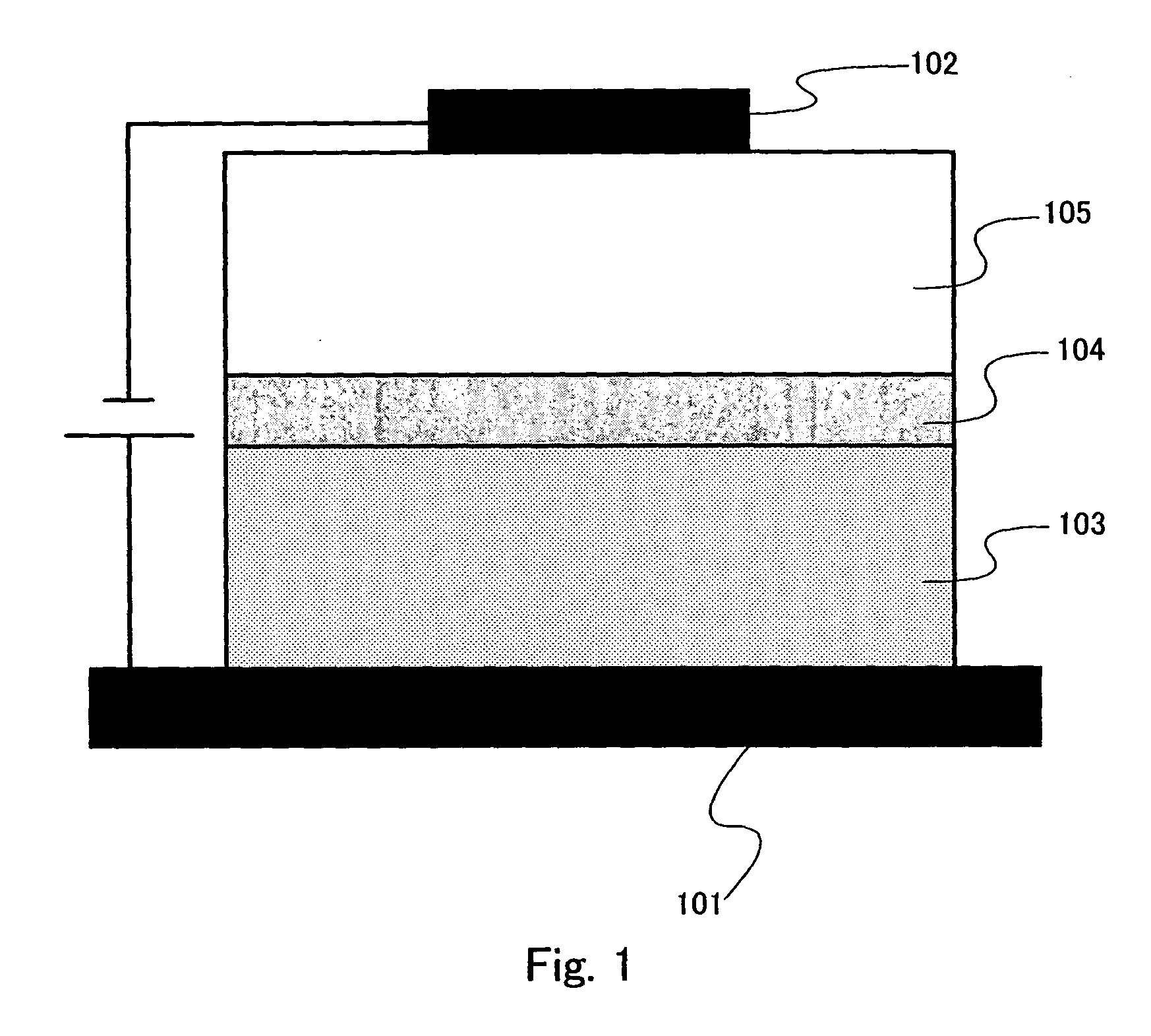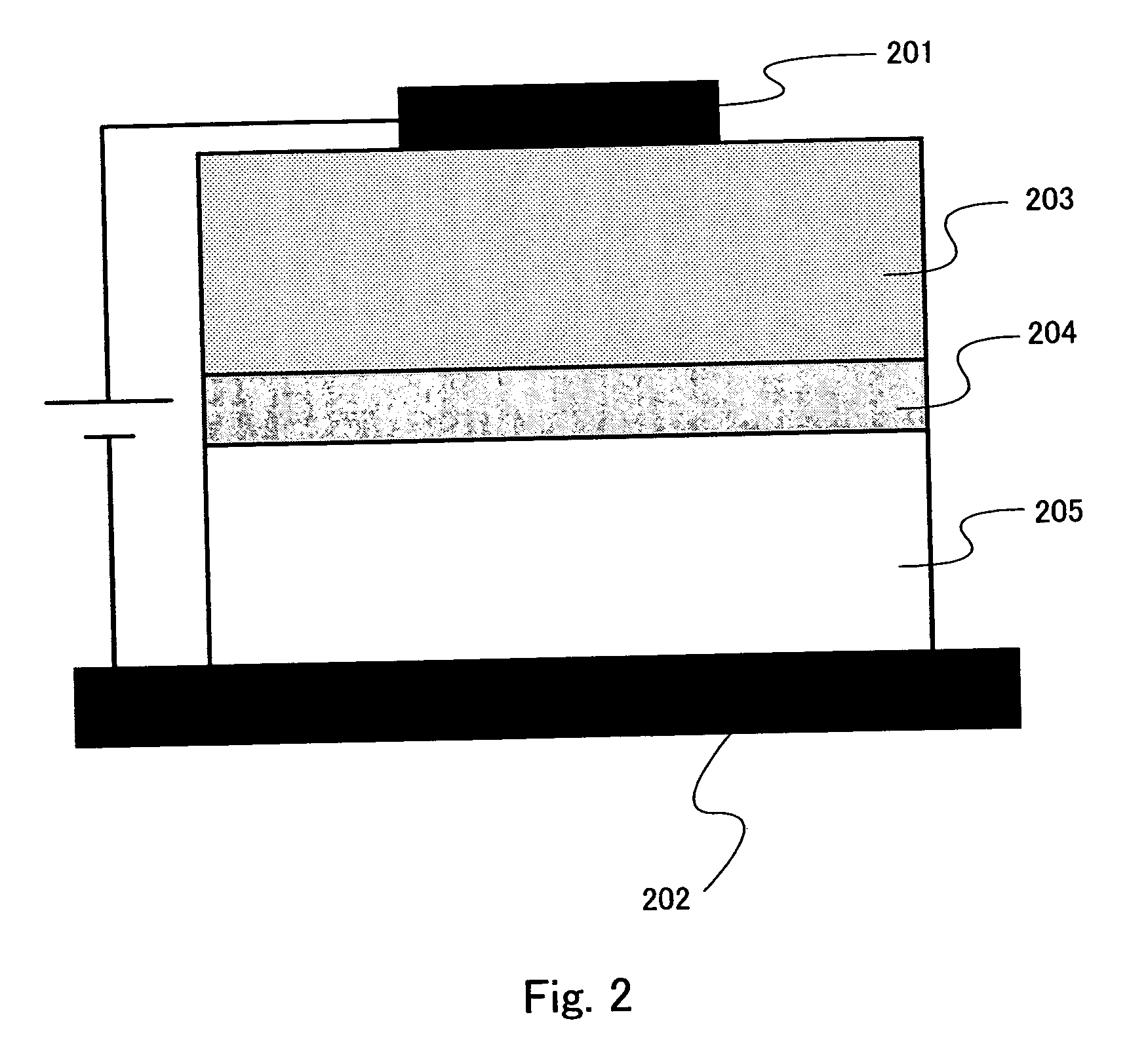Electroluminescence element and a light emitting device using the same
a technology of light emitting device and electroluminescent element, which is applied in the direction of discharge tube/lamp details, discharge tube luminescnet screen, organic semiconductor device, etc., can solve the problems of high noise, short circuit risk, and unnecessary backlight used in conventional liquid crystal display
- Summary
- Abstract
- Description
- Claims
- Application Information
AI Technical Summary
Problems solved by technology
Method used
Image
Examples
embodiment 1
[0115] For comparison to Embodiment 1, two kinds of devices are fabricated. First, conventional EL element that has the structure of "ITO (110 nm), CuPc (20 nm), .alpha.-NPD (30 nm), Alq (50 nm), CaF.sub.2 (2 nm), Al (100 nm)" is fabricated. The device is corresponded to the illustrated device structure in FIG. 4A and referred to as the device A hereinafter. In addition, the size of a pixel is 2-nm-square.
[0116] The EL element in which a floating electrode is not deposited different from a device structure according to Embodiment 1 that has the structure "ITO (110 nm), CuPc (20 nm), .alpha.-NPD (30 nm), Alq (150 nm), CaF.sub.2 (2 nm), Al (100 nm)" is fabricated. The device is corresponded to the illustrated device structure in FIG. 4B and referred to as the device B hereinafter. In addition, the size of a pixel is 2-nm-square.
[0117] The initial characteristics of the device A and device B is illustrated in addition to that of the device C in FIG. 6. The device C can be greatly impro...
embodiment 2
[0118] In this embodiment, an EL element according to the present invention shown in FIG. 1 will be specifically described. This embodiment will be described two examples that an EL element according to the present invention in which a hole blocking material is introduced into an electroluminescent film (hereinafter, an element D) and an EL element according to the present invention in which a hole blocking material is introduced into an electron transport supporting layer (hereinafter, an element E).
[0119] The structure of the device D is "ITO (110 nm), CuPc (20 nm), .alpha.-NPD (30 nm), Alq (40 nm), BCP (10 nm), CaF.sub.2 (2 nm), Al (20 nm), Au (20 nm), Alq (100 nm), CaF.sub.2 (2 nm), Al (100 nm)". The structure of the device E is "ITO (110 nm), CuPc (20 nm), .alpha.-NPD (30 nm), Alq (50 nm), CaF.sub.2 (2 nm), Al (20 nm), BCP (100 nm), Al (100 nm)". Hole blocking materials for the device D and device E are BCP. In addition, in either device, the size of the pixel is 2-nm-square.
[0...
embodiment 3
[0123] An EL element shown in FIG. 2 will be specifically described in this embodiment.
[0124] Basically, the device shown in FIG. 2 can be fabricated through the reverse process to that of FIG. 1. First, BCP is deposited to have a thickness of 100 nm as an electron transport supporting layer on the substrate on which Al is deposited to have a thickness of 100 nm as a cathode 202, and Al: Li alloy is deposited to have a thickness of 20 nm as a floating electrode 204 thereon.
[0125] Next, Alq as an electron transporting luminescent material is deposited to have a thickness of 50 nm, .alpha.-NPD as a hole transporting material is deposited to have a thickness of 30 nm, and CuPc as a hole injecting material is deposited to have a thickness of 20 nm in this order to form an electroluminescent film 203. Lastly, Au is deposited to have a thickness of 20 nm as an anode 201, and an EL element according to the present invention can be obtained. Light is extracted from the top surface (Au side)...
PUM
 Login to View More
Login to View More Abstract
Description
Claims
Application Information
 Login to View More
Login to View More - R&D
- Intellectual Property
- Life Sciences
- Materials
- Tech Scout
- Unparalleled Data Quality
- Higher Quality Content
- 60% Fewer Hallucinations
Browse by: Latest US Patents, China's latest patents, Technical Efficacy Thesaurus, Application Domain, Technology Topic, Popular Technical Reports.
© 2025 PatSnap. All rights reserved.Legal|Privacy policy|Modern Slavery Act Transparency Statement|Sitemap|About US| Contact US: help@patsnap.com



